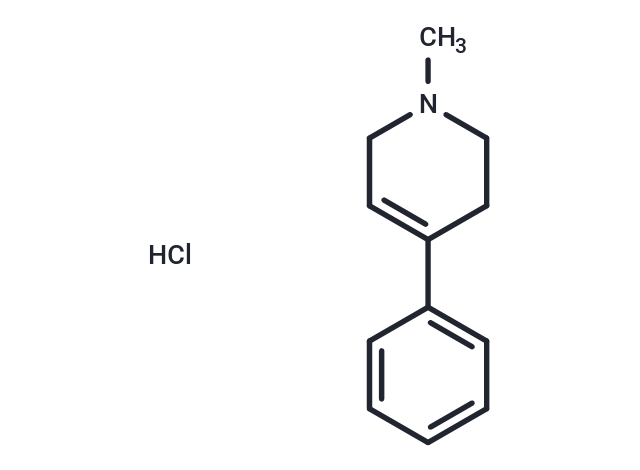Shopping Cart
Remove All Your shopping cart is currently empty
Your shopping cart is currently empty
MPTP hydrochloride is a dopamine neurotoxin and the precursor of MPP⁺. It can induce apoptosis and has the ability to cross the blood-brain barrier. MPTP hydrochloride is toxic to dopaminergic neurons and is commonly used for the construction of Parkinson's disease animal models.

| Pack Size | Price | USA Warehouse | Global Warehouse | Quantity |
|---|---|---|---|---|
| 5 mg | $30 | In Stock | In Stock | |
| 10 mg | $46 | In Stock | In Stock | |
| 25 mg | $77 | In Stock | In Stock | |
| 50 mg | $141 | In Stock | In Stock | |
| 100 mg | $197 | In Stock | In Stock | |
| 200 mg | $313 | In Stock | In Stock | |
| 500 mg | $496 | In Stock | In Stock | |
| 1 mL x 10 mM (in DMSO) | $48 | In Stock | In Stock |
| Description | MPTP hydrochloride is a dopamine neurotoxin and the precursor of MPP⁺. It can induce apoptosis and has the ability to cross the blood-brain barrier. MPTP hydrochloride is toxic to dopaminergic neurons and is commonly used for the construction of Parkinson's disease animal models. |
| Targets&IC50 | Phrenic nerve - diaphragm:53 mM, Phrenic nerve - diaphragm (Pretreatment with 4-phenylpyridine):18 mM |
| In vitro | METHODS: Human neuroblastoma cells M17 were treated with MPTP hydrochloride (1-50 μM) for 48 h. The expression levels of target proteins were detected by Western Blot. RESULTS: MPTP hydrochloride promoted Tau protein phosphorylation in M17 cells. [1] METHODS: Neuroblastoma cell N2AB-1 and glioma cell C6 were treated with MPTP hydrochloride (0.33-33.7 μM) for 24 h, and the growth curves were examined. RESULTS: MPTP hydrochloride did not affect the cell number of actively growing N2AB-1 or C6 cells. [2] |
| In vivo | METHODS: To construct a subacute Parkinson's model, MPTP hydrochloride (30 mg/kg in 0.9% saline) was administered intraperitoneally to C57BL/6 mice once daily for five days. RESULTS: Subacute MPTP hydrochloride treatment did not cause significant motor deficits, although the dopaminergic system was severely impaired. mPTP hydrochloride significantly increased the level of α-synuclein and the number of astrocytes in the striatum and disrupted the blood-brain barrier in the substantia nigra pars compacta. [3] METHODS: To study the effects of different models on the behavior and pathology of a mouse model of Parkinson's disease, MPTP hydrochloride was used intraperitoneally to construct a subacute model group and a chronic model group. In the subacute model group, MPTP hydrochloride (30 mg/kg) was administered once daily for ten days. In the chronic model group, MPTP hydrochloride (30 mg/kg) was injected once every 3.5 days for five weeks for ten times. RESULTS: In the MPTP hydrochloride-induced subacute Parkinson's disease mouse model, there was a small loss of dopaminergic neurons in the midbrain, but there was no effect on the behavior.The MPTP hydrochloride-induced chronic Parkinson's disease mouse model lost a large number of dopaminergic neurons, which was accompanied by anxiety-like behaviors in addition to motor dysfunction. [4] |
| Synonyms | MPTP-hydrochloride |
| Molecular Weight | 209.72 |
| Formula | C12H16ClN |
| Cas No. | 23007-85-4 |
| Smiles | Cl.CN1CCC(=CC1)c1ccccc1 |
| Relative Density. | no data available |
| Color | White |
| Appearance | Solid |
| Storage | keep away from moisture,keep away from direct sunlight | Powder: -20°C for 3 years | In solvent: -80°C for 1 year | Shipping with blue ice/Shipping at ambient temperature. | ||||||||||||||||||||||||||||||||||||||||
| Solubility Information | H2O: 10 mg/mL (47.68 mM), Sonication is recommended. DMSO: 23.86 mg/mL (113.77 mM), Sonication is recommended. | ||||||||||||||||||||||||||||||||||||||||
| In Vivo Formulation | 10% DMSO+40% PEG300+5% Tween 80+45% Saline: 1 mg/mL (4.77 mM), Sonication is recommended. Please add the solvents sequentially, clarifying the solution as much as possible before adding the next one. Dissolve by heating and/or sonication if necessary. Working solution is recommended to be prepared and used immediately. The formulation provided above is for reference purposes only. In vivo formulations may vary and should be modified based on specific experimental conditions. | ||||||||||||||||||||||||||||||||||||||||
Solution Preparation Table | |||||||||||||||||||||||||||||||||||||||||
H2O/DMSO
DMSO
| |||||||||||||||||||||||||||||||||||||||||
| Size | Quantity | Unit Price | Amount | Operation |
|---|

Copyright © 2015-2025 TargetMol Chemicals Inc. All Rights Reserved.